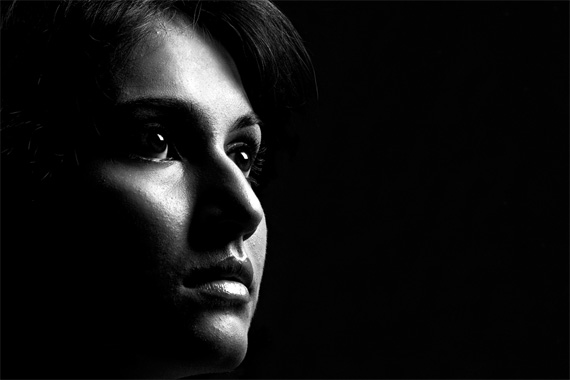Posted: 22 Feb 2012 10:17 PM PST Rembrandt lighting was named after of the great master, who often used it in his own portraits. The idea is to create a small inverted triangle of light on the subject’s cheek which is opposite the light source. This is very flattering (especially for people with prominent cheekbone structure) and was often used in old Hollywood portraits. It is important to ensure that you get catch lights in both eyes. What subjects does it work for?This technique works well for subjects will full or round faces (because it adds definition and slims the face), but is generally not a good choice for narrow faces. Some ‘old school’ photographers refer to Rembrandt lighting as ‘masculine’ and some really old school portrait photographers will insist that a woman should never be lit with Rembrandt Lighting. Since Rembrandt himself painted women using basic Rembrandt Lighting, you can safely assume that this ‘rule’ is a ‘guideline’ at best. Where does it fit in with other techniques?This is one of the 5 basic lighting setups used in studio portrait photography; the others being Broad, Short, Split Portrait and Butterfly. There are two things that make up Rembrandt Lighting; a light on one half the subjects face and a triangle of light on the shadowed side of the face (called a chiaroscuro). Technically the triangle shadow should be no wider than the eye, and no longer than the nose. The thing that distinguishes Rembrandt Lighting from simple short lighting is the triangle of light, This method can be considered simply a variation of short lighting. When the lighting is such that the shadow of the nose reaches the shadow side of the face and forms a triangle on the short side of the face, it is referred to as Rembrandt lighting. Set-up:At its most basic level this lighting method is constructed with a single light source placed approximately 45 degrees offset from the subject and a bit higher than eye level, lighting the side of the face that is farthest from the camera. This single light source is often supplemented with a reflector or a second light placed approximately 45 degrees to the shadowed side of the face and set at ½ the power of the main light source (called the key light). This is used to lift the shadows on the darker side of the face (for those of you reading this by email you can see the video here). Conclusion:Rembrandt lighting is a simple, effective lighting set-up that is flattering to a wide variety of subjects and is easy to master quickly. It’s possible to achieve using a single diffused flash unit and homemade reflector. About the Author: Chas Demain is from creativeslrphotography.com. For Further Training on Supplemental Lighting in Photography, PictureCorrect Suggests:These eBooks contains valuable information designed to help you learn and master the complicated art of adding artificial light to photography. Join the discussion of this article on facebook: PictureCorrect on Facebook Article from: PictureCorrect Photography Tips |
Posted: 22 Feb 2012 10:30 AM PST Yosemite is, without a doubt, a true nature photographers playground. So much in fact, a section of the park is named in honor of famous photographer, Ansel Adams. Colin Delehanty recently spent four days with a fellow photographer, Sheldon Niel, to create this four minute timelapse of the park. This project has now received media attention worldwide and millions of people have seen since it was released a few weeks ago. Take a moment and enjoy (for those of you reading this by email you can see the video here):
Yosemite National Park spans over 700,000 acres and is home to some of North Americas most diverse wildlife. The park’s sweeping valleys, lush with ancent sequoia trees, perfectly complement the giant granite slopes and waterfalls that fall from them. The two photographers shot these timelapses on a Canon 5D Mark II with a Carl Zeiss 135mm telephoto lens. One of the most difficult aspects to creating timelapse videos in such remote areas is lugging their gear around. While some locations were only a block or two away from their camp, many of the locations were over a two mile hike away. Not only were they carrying the heavy DSLR, but they were also brought along the Dynamic Peception MILapse Dolly and MX2 controller, 6-foot aluminim rails, and a steadycam merlin. To capture the footage, they two would first scout for locations, then drive their car as close in as possible. They would then have to carry their gear to the new site. “Its pretty challenging to hike up with all the equipment and sometime things don’t work out, like, forgetting to bring something like a quick release plate or your batteries,” recalls Delehanty. “You’re bringing so much stuff, it’s the easiest thing to forget the smaller stuff and some of the smaller things are the most important.” Most of the clips were taken over a course of four or more hours, with the assistant of the MX2 controller. The merlin allowed them to not only create sweeping shots but also give them the ability to pan and tilt the camera automatically. You can take a look at how the how the crew used the set up in this documentary, shot by Dalton Runberg, who was along for the shoot (for those of you reading this by email you can see the video here). Join the discussion of this article on facebook: PictureCorrect on Facebook Article from: PictureCorrect Photography Tips |
Tags:






0 comments:
Post a Comment